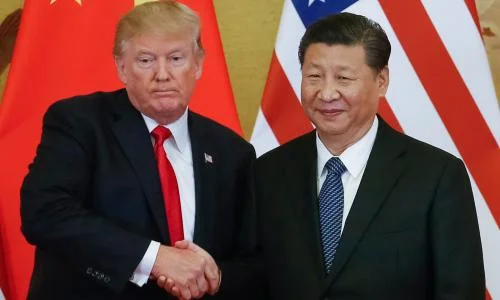
In a sharp escalation of trade tensions, China announced it will impose 84% tariffs on U.S. goods, starting April 10, in response to the Trump administration’s latest tariff hike on Chinese imports. This tit-for-tat move has sent shockwaves through global markets, further straining the already fragile relationship between the world’s two largest economies.
According to a translated notice from China’s Office of the Tariff Commission, the tariffs mark a jump from 34% to 84% on a wide range of American goods. This comes after President Donald Trump implemented a new tariff policy, including a 104% total levy on many Chinese imports, citing unfair trade practices and the need to protect American jobs and industries.
While headlines focus on the immediate market impact—the S&P 500 dropping nearly 20% from its peak, Asian indexes tumbling, and investor confidence shaken—the bigger issue remains: China is not simply a trade partner; it is a strategic competitor using economic tools to challenge U.S. dominance.
U.S. Treasury Secretary Scott Bessent called China the “worst offender in the international trading system,” stating the country has “the most imbalanced economy in the history of the modern world.” He added that this latest escalation “is a loser for them”—but many analysts argue it’s also a warning for us.
China’s retaliation isn’t just about tariffs. It’s about asserting influence, leveraging dependencies, and weakening America's global position through financial means. For years, China has exploited trade loopholes, stolen intellectual property, and manipulated currency—all while expanding its geopolitical ambitions.
Now, with its bold move to raise tariffs, China is signaling it will not back down. And Americans should be asking: What is the long-term goal of the Chinese Communist Party (CCP)? Is this just about soybeans and semiconductors—or is it part of a broader push to reshape the global order on Beijing’s terms?
The U.S. imported nearly $439 billion in goods from China in 2024, while exporting just $143.5 billion—a glaring imbalance reflecting decades of offshoring and dependency. For too long, America has allowed strategic industries—from pharmaceuticals to rare earth minerals—to be outsourced, often to China.
And this is not without consequence. The same regime that floods our markets with cheap electronics is also linked to fentanyl precursors fueling America’s opioid crisis, aggressive cyber-espionage, and a military buildup that threatens Indo-Pacific stability.
The current trade conflict is not just economic policy—it’s a test of national resilience. China is betting that American divisions and short-term thinking will prevent a unified response. That’s why this moment is critical.
As the U.S. pushes forward with its new tariff policy, it must go further—investing in critical industries, enforcing trade laws, securing supply chains, and reducing exposure to China.
This doesn’t mean total decoupling, but it does mean acknowledging that China is not a benign actor. Its retaliatory tariffs are part of a broader strategy to pressure and intimidate.
Americans should support a bipartisan approach to confront this challenge with strength and unity. Whether you’re a farmer, tech entrepreneur, or factory worker, this economic battle affects your future.
The trade war may dominate headlines, but the bigger war is for economic sovereignty, technological leadership, and global influence. It’s time to recognize what’s truly at stake.